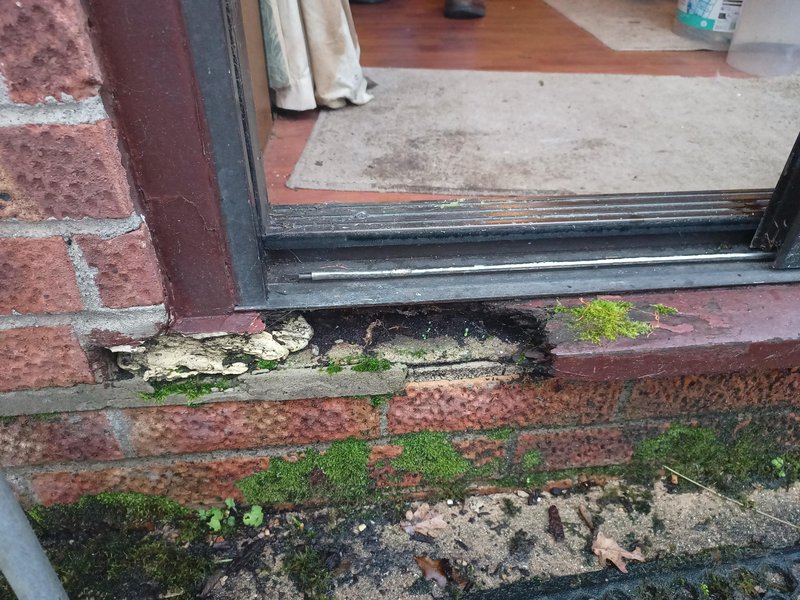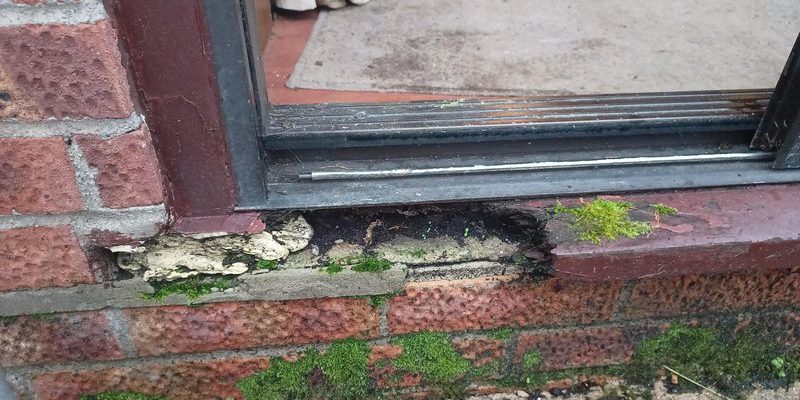
Here’s the thing: An exterior door sill gets the worst of everything—rain, melting snow, muddy boots, and direct sun. Over time, all that exposure adds up. Even well-made composite or metal-clad sills aren’t immune if water is sneaking in somewhere it shouldn’t. Let’s get into *why* this happens, what you can do about it, and how to keep your door sill solid for years to come.
What Causes Door Sill Rot In The First Place?
Rot usually means one thing: water is getting where it shouldn’t, and it’s sticking around long enough for trouble to start. Most exterior door sills are made from wood, a wood core, or a wood frame under a thin layer of metal or vinyl. That protective layer is only as good as the seal around it. If caulk cracks, paint chips, or a gap opens, water seeps in.
Once moisture gets beneath the surface, the wood fibers start to break down. Fungi move in and eat away at the wood, causing it to soften and decay. You might see dark stains, feel mushiness underfoot, or notice that your door doesn’t quite sit square anymore. If you have a fancy programmable lock or a wireless remote entry system, rot can even cause code and sync issues—door movement might throw off the alignment or even short out low-battery electronics.
Here’s what really gets most homeowners: Rot doesn’t just show up after a huge storm. It creeps in quietly, building up from small leaks or condensation over months (or longer). If you wait until you feel a soft spot, the damage is probably bigger than it looks from the outside.
How To Identify Rot On An Exterior Door Sill
Spotting rot early is your best defense. If you’re not sure what to look for, start with a simple test. Press your thumb or the handle of a screwdriver into the sill. If it gives easily or crumbles, that’s rot. Sometimes, rot shows up as swelling, peeling paint, or grayish-black stains—signs that water’s been sitting there for a while.
Pay special attention to the *ends* of the sill, where it meets the door frame. That’s where water tends to pool or wick upward. On steel-clad or composite sills, look for bulges or bubbling under the surface. Any kind of squishiness is a red flag. With some entry systems, a door that suddenly sticks or won’t “sync” properly with your electronic remote could be a hint that the frame is shifting because of underlying rot.
If you see mushrooms, mold, or musty smells, the rot is already advanced. At that point, you’ll probably need more than a little sanding and paint.
Why Does Rot Happen So Often—Even On Newer Doors?
You might be wondering why rot is such a common headache, even on new or high-end exterior doors. It comes down to three main reasons:
- Poor Installation: If the installer skipped steps (like sealing under the sill or using the wrong caulk), gaps pop up fast. Water finds those gaps every time it rains or snows.
- Lack of Maintenance: Door sills need touch-ups—fresh paint, new beads of sealant, or cleaning out leaf debris. Ignoring maintenance lets little problems turn into big ones.
- Cheap Materials: Some builders use basic pine or particleboard for hidden parts of the sill. Even if the outer shell looks tough, the inside might rot quickly if water sneaks past.
Honestly, even some fancy composite or steel doors have hidden wood under the metal or vinyl. Once a remote door lock installer drilled too many holes in a client’s door sill and moisture got in around those gaps—rot popped up just a year later. High-tech doesn’t always mean high-durability if water gets a sneaky access point.
How Door Sill Rot Impacts Security And Performance
Rot isn’t just ugly. It can mess with the security and energy efficiency of your whole entryway. For starters, a soft sill makes it easier for someone to kick in the door, since the frame and lock area aren’t as solid as they should be. If you’re using an electronic deadbolt or push-button code entry, the movement from a sinking or shifting sill can make it hard for the lock to “reset” or line up properly.
Rot also means air and moisture are getting in. That can make the rest of your door freeze up in winter, or let warm, humid air invade your nicely conditioned home in the summer. Mold and mildew love moist, rotting wood, which can create bad smells and even trigger allergies.
A quick story: One homeowner kept replacing batteries in their wireless remote lock because moisture from rot was shorting out the electronics inside the sill. The key? Fix the rot, not just the symptoms.
How To Prevent Rot On Exterior Door Sills
Prevention is way easier (and cheaper) than replacement. Here’s how you can keep your door sill solid, even if you’re not super handy:
- Keep It Sealed: Check and refresh caulking around your door sill every year. Look carefully at corners and any seams where different materials meet, especially near codes or remote sensors.
- Touch Up Paint: Bare or chipped paint is an invitation for water to get in. Any time you see a scratch or nick, hit it with outdoor-rated paint.
- Keep It Clean: Clear away dirt, leaves, and snow from the sill. Debris holds moisture in place, speeding up the rot process.
- Watch For Leaks: After heavy rain, check inside and out for puddles or dampness. If you find any, trace the source and fix it right away.
For doors with high-tech locks or remotes, make sure wiring and battery compartments are sealed, too. Even small leaks near connected devices can cause trouble down the line.
What To Do If You Spot Early Signs Of Sill Rot
Don’t panic if you catch rot early—it’s usually possible to stop it before it wrecks the entire sill. Start by removing loose or soft material with a screwdriver or putty knife. Let the area dry completely. Then treat the exposed wood with a wood hardener (look for ones made for exterior use).
After the hardener cures, fill the area with an exterior-grade wood filler or epoxy. Sand it smooth and repaint with weatherproof paint. This quick fix can buy you years if the damage isn’t too deep. If you use a remote or electronic lock, be sure to check all connections and reset them if any wires or batteries got wet during your repair.
If the rot goes deeper than a few millimeters, or if the whole end of the sill is mushy, you’ll probably need to replace the entire sill or the lower section of the door frame. That’s a more involved job, but it’s doable for a confident DIYer—or a quick call for a pro.
Should You Replace Or Repair A Rotting Door Sill?
Here’s where it gets tricky: Sometimes a simple repair just isn’t enough. If the sill, jamb, or frame is completely rotted through, you’re better off replacing the damaged part before it spreads. Replacement sills come in wood, composite, and metal options. Composites—like those used in some newer Masonite and Therma-Tru doors—are the most rot-resistant, since there’s no real wood to break down. Metal sills with a solid, sealed core are also a safer bet for long-term durability.
If your old sill is wood, and you’re already replacing it, consider upgrading. You’ll save yourself a lot of future headaches. Just make sure the new part fits your door’s brand and size, and re-seal everything carefully.
Best Practices For Door Sill Maintenance Long-Term
Routine care is key. Set a reminder to check your door sill with the change of each season—just like you might reset your clocks or check your remote’s battery. Give the bottom of your door a quick look every time you mow the lawn or sweep the entryway.
- Inspect after storms: Heavy rain or snow melt is when leaks show up most easily.
- Re-seal and re-paint: Even small touch-ups add years to a sill’s life.
- Upgrade hardware: If you add a new wireless remote, deadbolt, or smart system, double-check that no holes or wires are letting water sneak in.
Document any repairs, so you know exactly when you last checked or re-sealed. If you move, it’s a great thing to tell the next homeowner, too.
Tip: Prevention is a habit, not a one-time fix. Your door sill doesn’t need a ton of attention—just a little regular care.
When To Call In A Pro For Sill Rot
Not all rot jobs are DIY-friendly. If the sill damage has reached the subfloor, framing, or is spreading into the walls, it’s best to call a pro. The same goes for doors with lots of electronics—like remotes, sensors, or keypads—since improper repairs can cause sync or battery problems down the line.
Professionals can remove and reset a full door system, replace the sill and frame, and fix any hidden moisture issues. They’ll also be able to re-install or troubleshoot electronic remotes, replace wiring, and seal everything up tight. It’s worth it if you want the job done right—and quickly.
A freshly repaired door sill means a safer, stronger, and way better-looking front entry. And, honestly, knowing you’ve stopped rot in its tracks just feels good.
Keep Your Door Sill Rot-Free For Good
Spotting early signs of exterior door sill rot might seem like a small thing, but addressing it right away keeps bigger problems at bay. It really comes down to this: A solid, well-sealed sill does more than protect your entry—it keeps your home secure, efficient, and looking its best. Whether your door is classic wood or a high-end Therma-Tru with remote entry, a little attention to seals, paint, and routine checks goes a long way. Take care of those soft spots as soon as you notice them, and you’ll save yourself time, money, and hassle for years to come.
